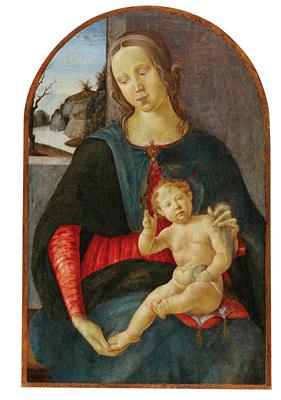Davide Ghirlandaio

(Florence 1452–1525)
The Madonna and Child,
oil on panel, arched top, 82 x 52.5 cm, framed
Provenance:
with San Giorgio Gallery, Rome, from 1912;
with Ehrich Galleries, New York, from 1926;
M. M. Gabriel, New York;
sale, Sotheby’s, New York, 16 June 1977, lot 102 (as Sebastiano Mainardi);
sale, Sotheby’s, London, 4 December 2014, lot 122 (as Davide Ghirlandaio);
where acquired by the present owner
Literature:
Galerie Sangiorgi, Rome, Catalogue des Objets d’Art Ancien pour l’année 1913, Venice 1913, p. 7 (as Sebastiano Mainardi)
The present painting is registered in the Fototeca Zeri under no. 11400 (as Davide Ghirlandaio).
Davide Ghirlandaio, the younger brother of Domenico Ghirlandaio (1444–1494), worked as a painter and mosaicist and eventually took over the Ghirlandaio workshop after his brother’s death. His prestigious commissions included the mosaic façades of the Orvieto and Siena Cathedrals, now destroyed, as well as the high altar for the church of Santa Maria Novella in Florence.
The present painting shows the Madonna and Child in an interior. A mountainous, barren landscape is revealed through the window in the background. The seated Madonna appears pensive and self-absorbed, whereas the Christ Child on her lap actively engages the viewer. The elegance of the Madonna’s features express the ideal of the Florentine Renaissance: her slightly inclined head, the soft facial expression with the lowered eyes, her bright, golden hair, covered by a translucent veil, the elongated fingers and sumptuous drapery with a jewelled brooch.
The intimate and imaginative interaction between mother and child relies on the tactile iconography of the Madonna holding the foot and shoulder of the Christ Child. The origins of this motif are to be found in the Byzantine type of the Tender Mother, which gained popularity in Tuscan, especially Sienese, painting starting from the thirteenth century (see R. Corrie, Coppo di Marcovaldo’s Madonna Del Bordone and the Meaning of the Bare-Legged Christ Child in Siena and the East, in: Gesta, 1996, vol. 35, pp. 51-53).
With his choice of composition, Davide Ghirlandaio was inspired by his significant predecessors: such as Masolino’s Carnasecchi Madonna (Kunsthalle Bremen), Fra Angelico’s Madonna of Humility (Museo Nazionale di San Matteo, Pisa) or Andrea del Verrocchio’s Madonna and Child (Gemäldegalerie Berlin). Recent cleaning removed some nineteenth century overpainting to the eyes, revealing the original, lowered view with half-closed eyes.
Specialist: Mark MacDonnell
 Mark MacDonnell
Mark MacDonnell
+43 1 515 60 403
mark.macdonnell@dorotheum.at
08.06.2021 - 16:00
- Realized price: **
-
EUR 106,550.-
- Estimate:
-
EUR 30,000.- to EUR 40,000.-
Davide Ghirlandaio
(Florence 1452–1525)
The Madonna and Child,
oil on panel, arched top, 82 x 52.5 cm, framed
Provenance:
with San Giorgio Gallery, Rome, from 1912;
with Ehrich Galleries, New York, from 1926;
M. M. Gabriel, New York;
sale, Sotheby’s, New York, 16 June 1977, lot 102 (as Sebastiano Mainardi);
sale, Sotheby’s, London, 4 December 2014, lot 122 (as Davide Ghirlandaio);
where acquired by the present owner
Literature:
Galerie Sangiorgi, Rome, Catalogue des Objets d’Art Ancien pour l’année 1913, Venice 1913, p. 7 (as Sebastiano Mainardi)
The present painting is registered in the Fototeca Zeri under no. 11400 (as Davide Ghirlandaio).
Davide Ghirlandaio, the younger brother of Domenico Ghirlandaio (1444–1494), worked as a painter and mosaicist and eventually took over the Ghirlandaio workshop after his brother’s death. His prestigious commissions included the mosaic façades of the Orvieto and Siena Cathedrals, now destroyed, as well as the high altar for the church of Santa Maria Novella in Florence.
The present painting shows the Madonna and Child in an interior. A mountainous, barren landscape is revealed through the window in the background. The seated Madonna appears pensive and self-absorbed, whereas the Christ Child on her lap actively engages the viewer. The elegance of the Madonna’s features express the ideal of the Florentine Renaissance: her slightly inclined head, the soft facial expression with the lowered eyes, her bright, golden hair, covered by a translucent veil, the elongated fingers and sumptuous drapery with a jewelled brooch.
The intimate and imaginative interaction between mother and child relies on the tactile iconography of the Madonna holding the foot and shoulder of the Christ Child. The origins of this motif are to be found in the Byzantine type of the Tender Mother, which gained popularity in Tuscan, especially Sienese, painting starting from the thirteenth century (see R. Corrie, Coppo di Marcovaldo’s Madonna Del Bordone and the Meaning of the Bare-Legged Christ Child in Siena and the East, in: Gesta, 1996, vol. 35, pp. 51-53).
With his choice of composition, Davide Ghirlandaio was inspired by his significant predecessors: such as Masolino’s Carnasecchi Madonna (Kunsthalle Bremen), Fra Angelico’s Madonna of Humility (Museo Nazionale di San Matteo, Pisa) or Andrea del Verrocchio’s Madonna and Child (Gemäldegalerie Berlin). Recent cleaning removed some nineteenth century overpainting to the eyes, revealing the original, lowered view with half-closed eyes.
Specialist: Mark MacDonnell
 Mark MacDonnell
Mark MacDonnell
+43 1 515 60 403
mark.macdonnell@dorotheum.at
|
Buyers hotline
Mon.-Fri.: 10.00am - 5.00pm
old.masters@dorotheum.at +43 1 515 60 403 |
| Auction: | Old Master Paintings I |
| Auction type: | Saleroom auction with Live Bidding |
| Date: | 08.06.2021 - 16:00 |
| Location: | Vienna | Palais Dorotheum |
| Exhibition: | 29.05. - 08.06.2021 |
** Purchase price incl. charges and taxes
It is not possible to turn in online buying orders anymore. The auction is in preparation or has been executed already.
